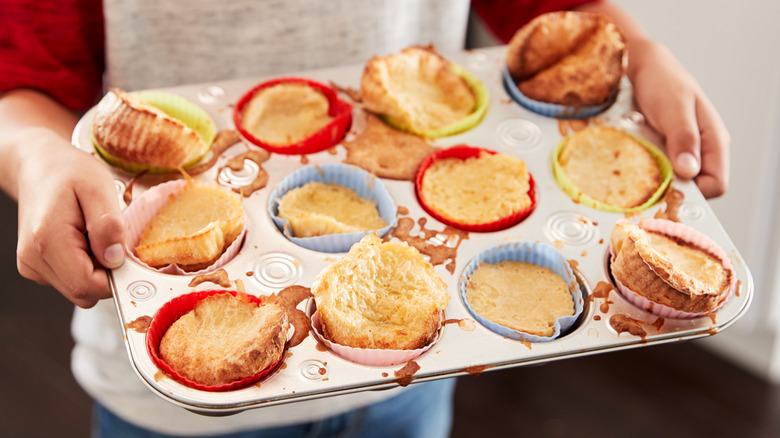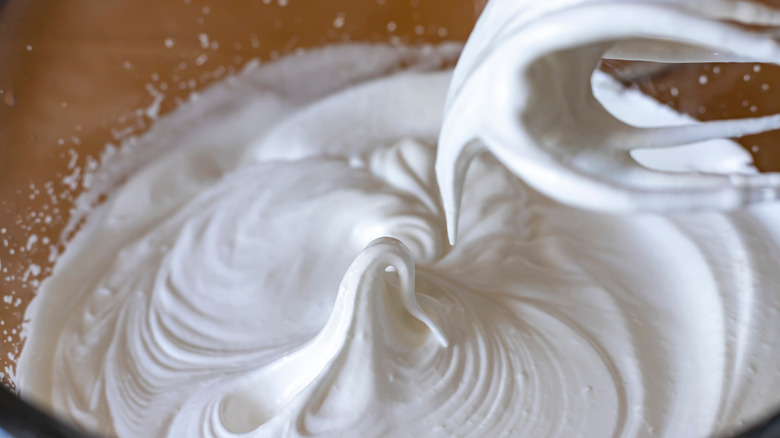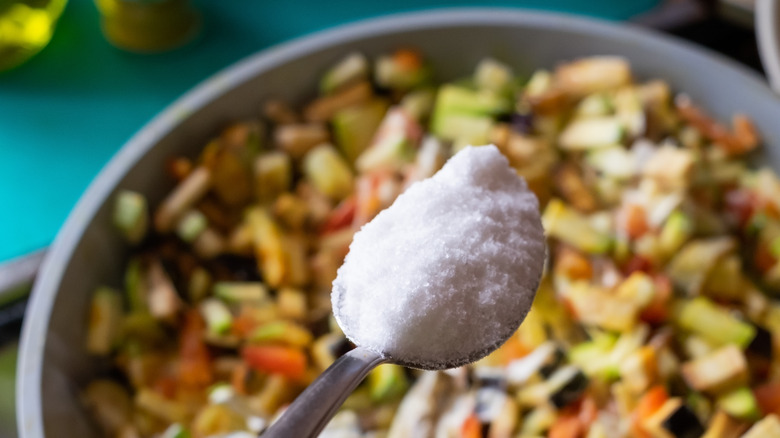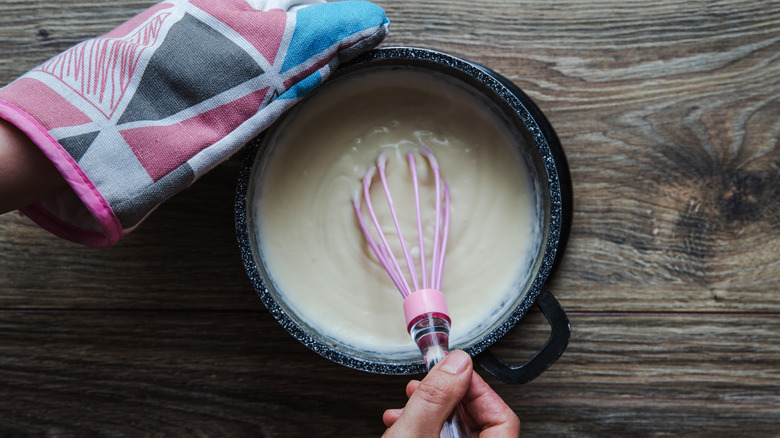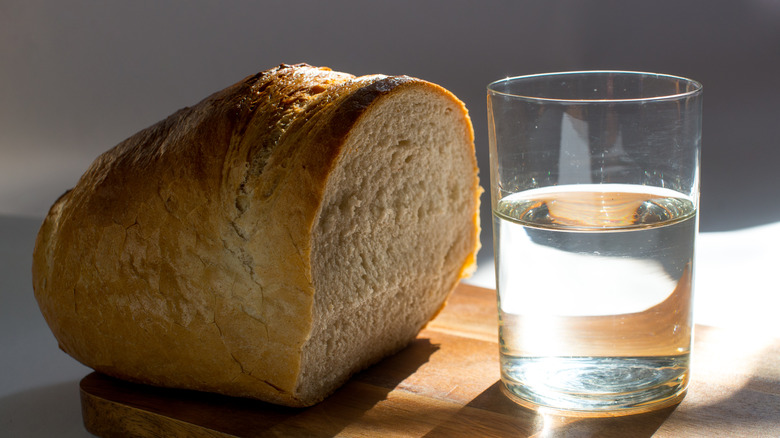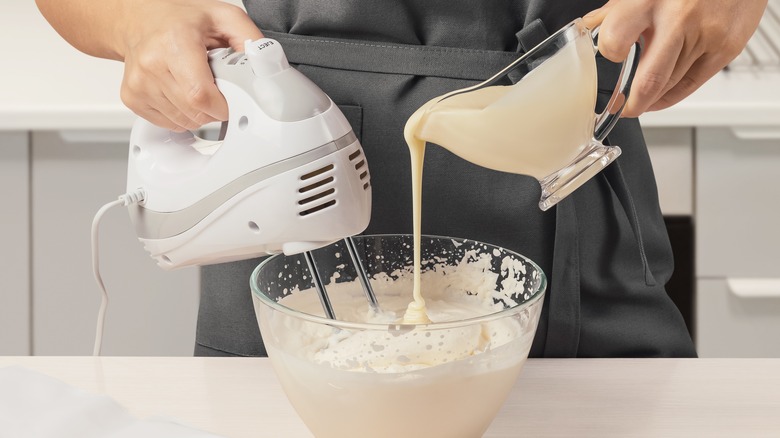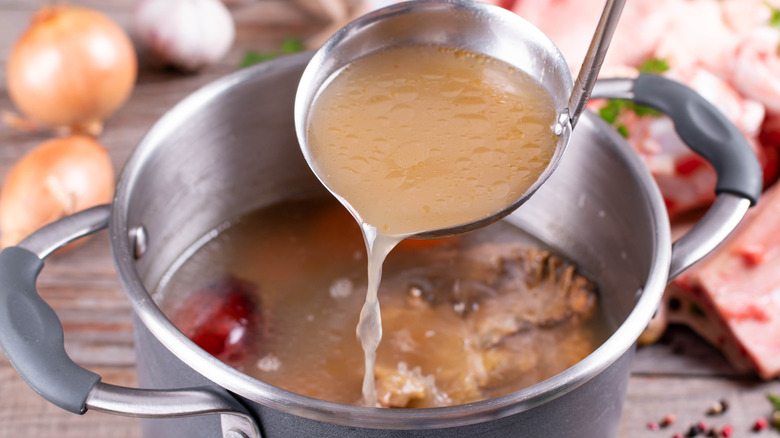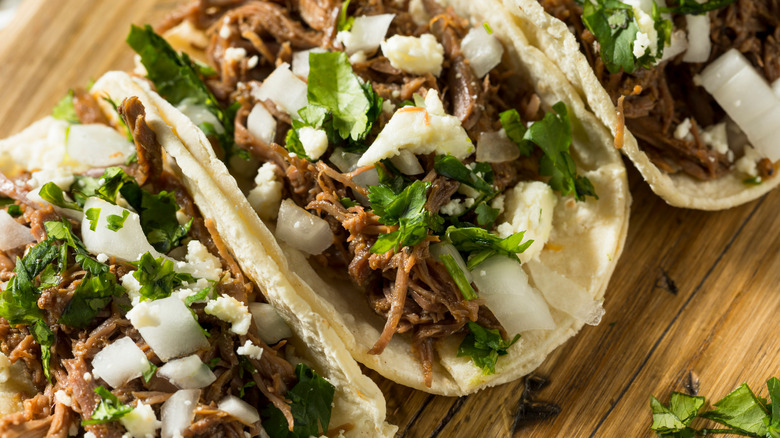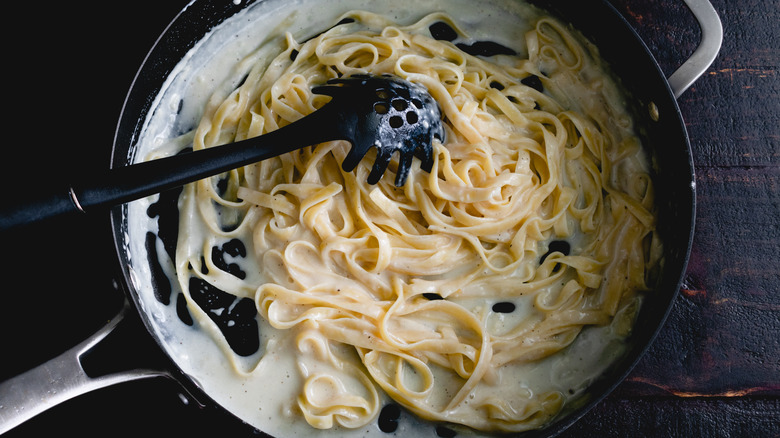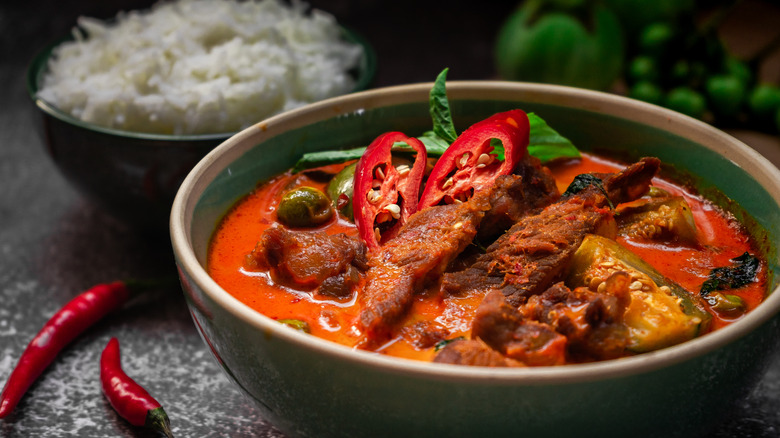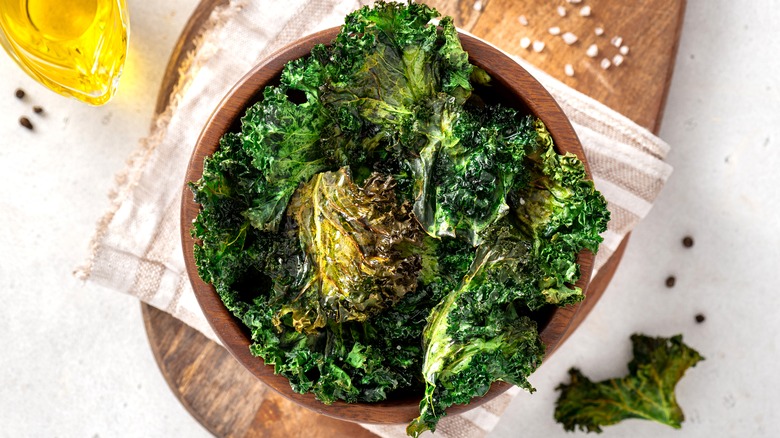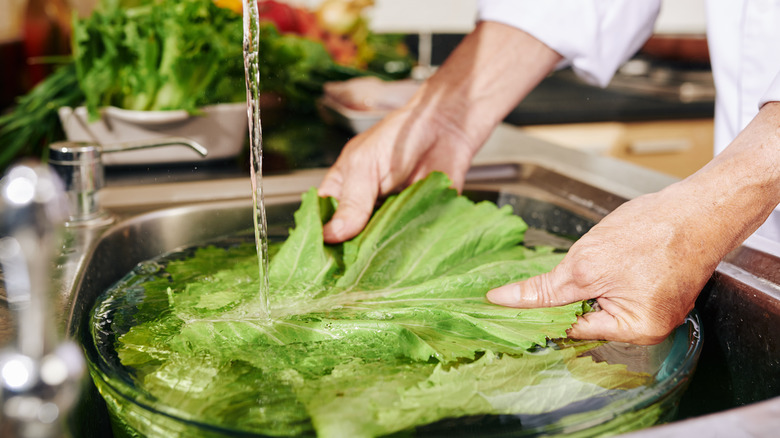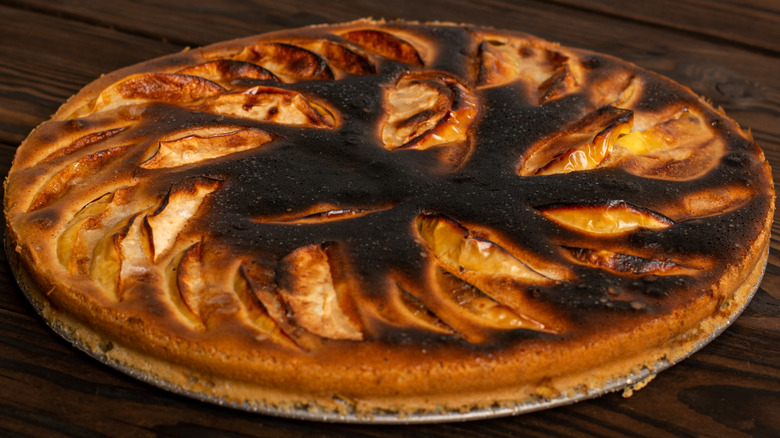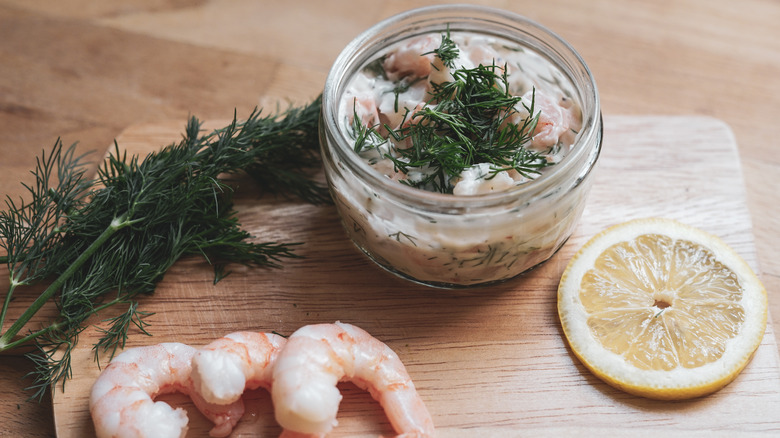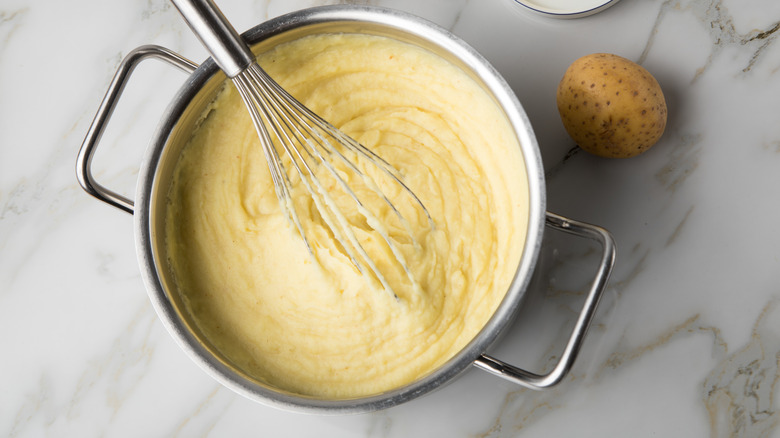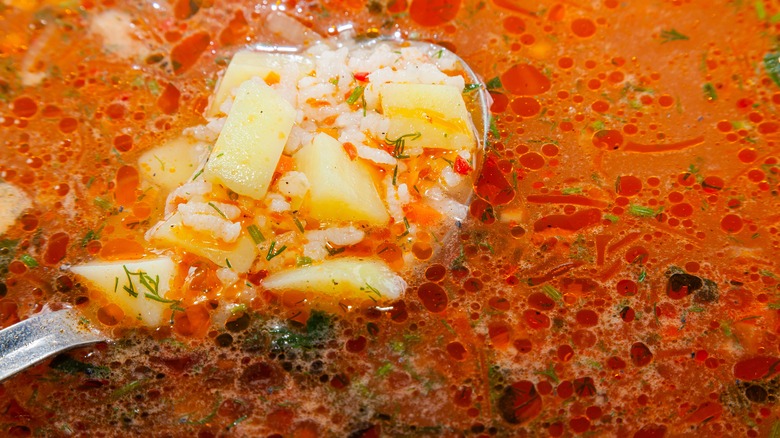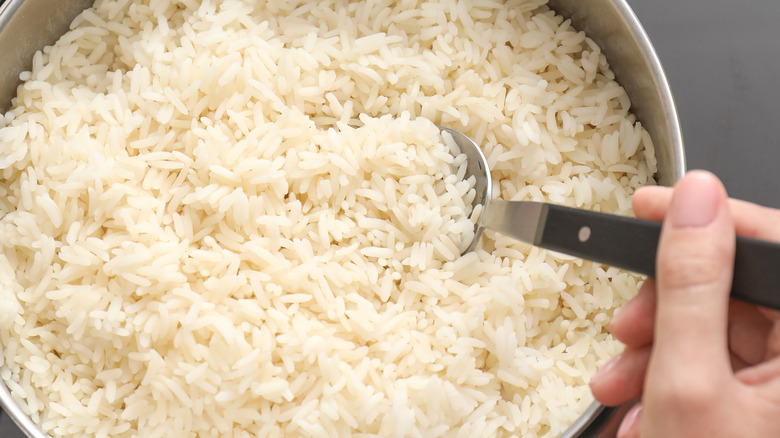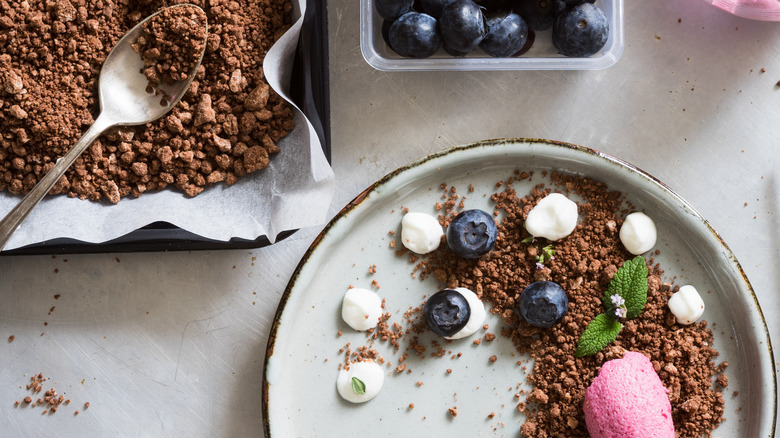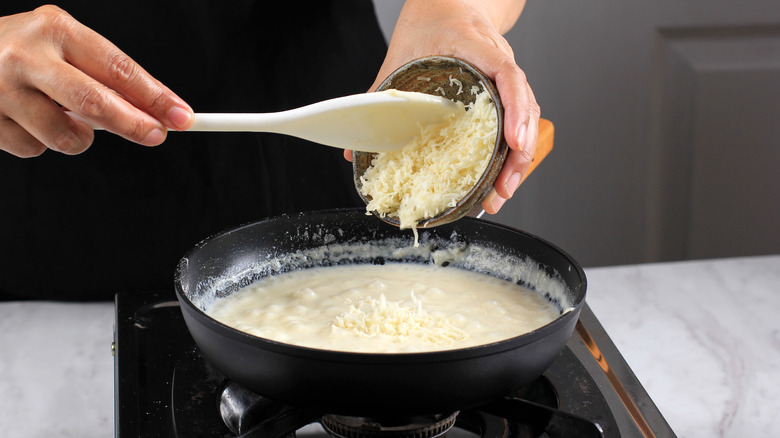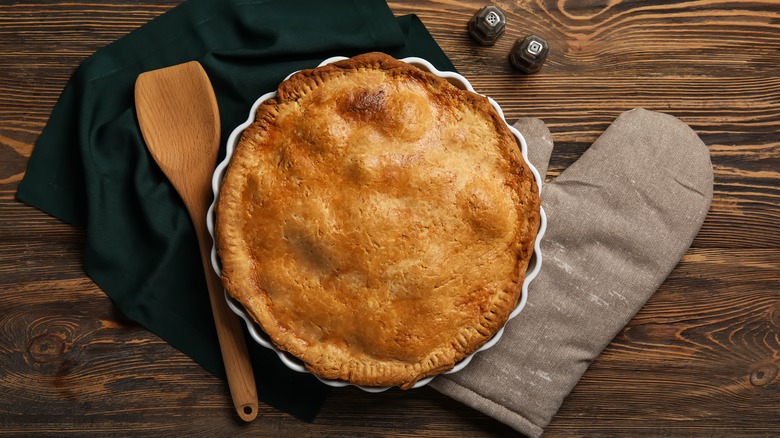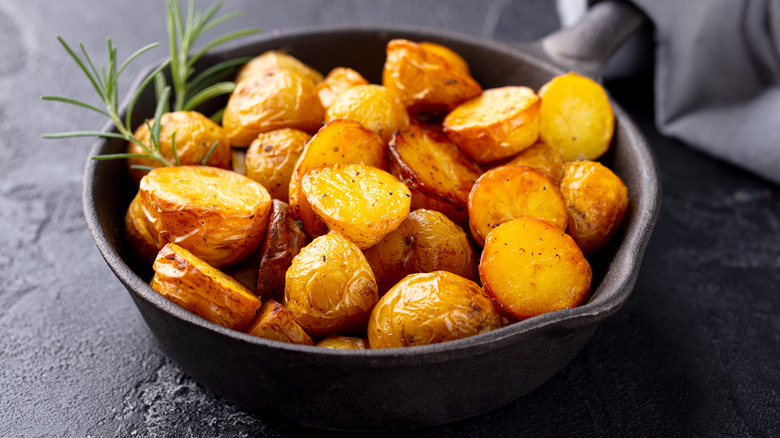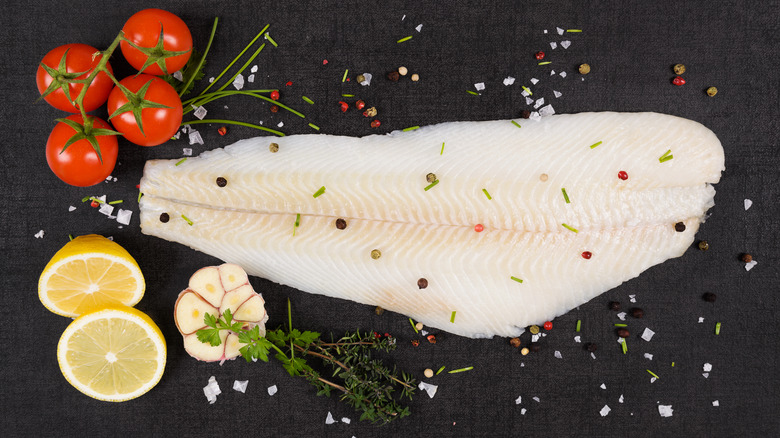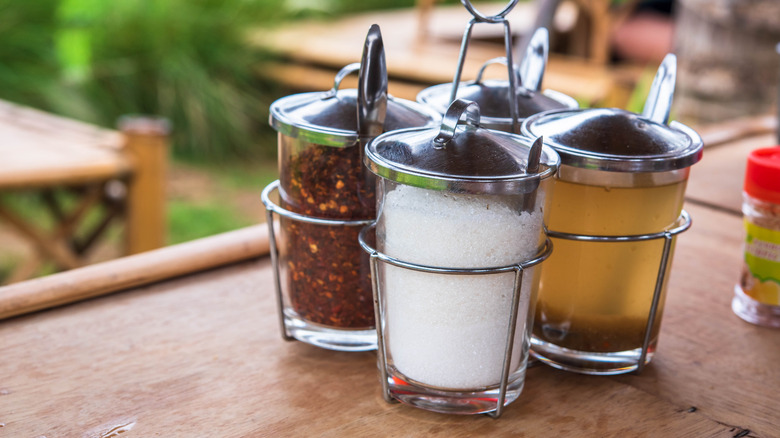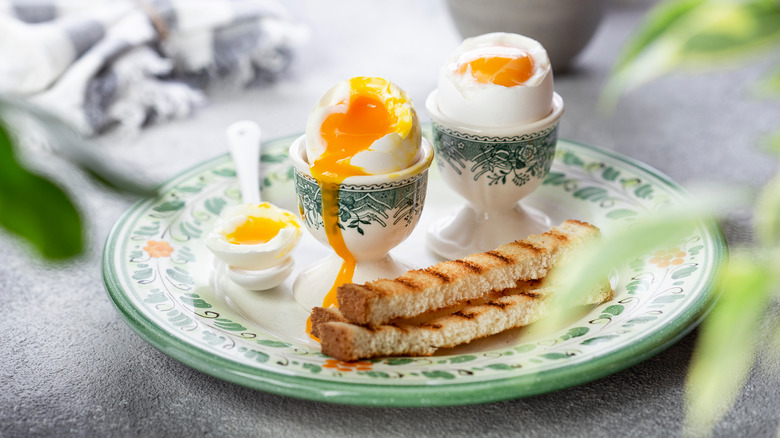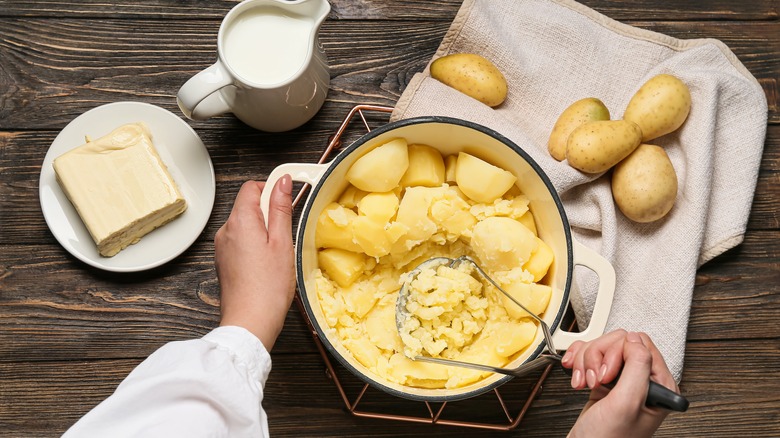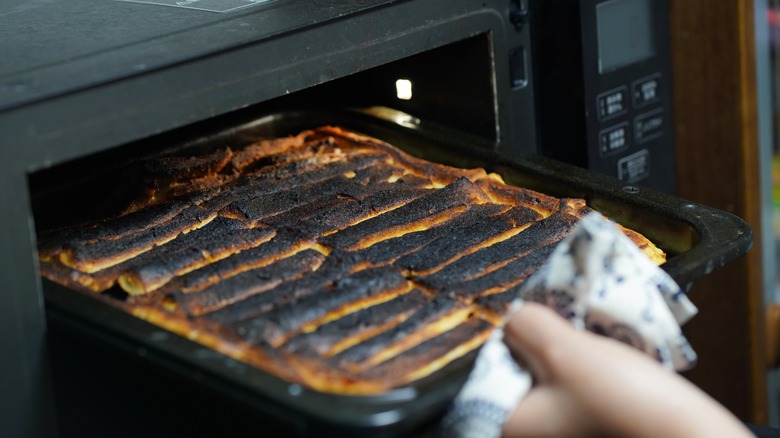26 Tips To Fix Cooking Disasters In The Kitchen
From burning dishes to splitting sauces and everything in between — if you think about it, there's so much that can actually go wrong in the kitchen. Of course, with the potential to cook up a storm of outrageously good dishes, too, mastering how to cook is a worthwhile endeavour. However, even seasoned pros can experience mishaps, and even something as simple as mashed potatoes can become a challenge, turning out to be too watery or too dry. While some mistakes, like forgetting an ingredient, can be easily remedied, certain cooking disasters can ruin a dish — or just nearly. Before you throw that overcooked beef into the bin or give up on trying to make your meringues peak, consider if there's a fix first.
Culinary advice often focuses on what to do to achieve perfection, or at least close to it. Knowing how to bake a pie so that the crust on top isn't burnt and the pastry case isn't underdone is really useful. But what do you do if it's too late, if the mistakes have already been made? What do you do if your stew is too salty or your curry is too sweet? Is there a way of rescuing soggy rice or noodles that have boiled too long and gone soft? Kitchen calamities are common — in order to save your nearly ruined efforts next time, read on for some nifty tips to handle a multitude of culinary issues and cooking disasters.
Remedy split hollandaise sauce
First of all, if you're making your own hollandaise sauce then kudos to you. Homemade is so much better, and while it's not complicated to make, it is somewhat difficult to master in that there's always the risk that your sauce will split. Of course you can start again, if you have all the ingredients on hand, and the time. But, if you want to rustle up a creamy eggs benedict for brunch, look to Leiths School of Food and Wine for a quick tip to fix a common problem when making hollandaise.
They say the sign that your sauce is starting to split is when it becomes oily and thickens up. Save it straightaway by removing it from the heat and adding an ice cube to cool it down. Stir this into the liquid so that it starts to come back together again. The color may change as the sauce relaxes as it takes in more of the butter.
This method won't work if your sauce has already split. If this happens, don't throw it away. Instead, you need to half make it again. Start with a clean bowl and add an egg yolk and some reduction as if you're starting again. Make the reduction with wine vinegar, peppercorns, water, bay leaf, and mace blade in that's been simmered, reduced, and strained. Next, add the split sauce to the bowl, stir to combine, and then some butter at the end.
Turn runny meringues into stiff peaks
If the thought of baking your own meringue feels daunting, then it's good to be reminded that this is one of the easiest and loveliest desserts, even though may need to put some whisking action in. That doesn't mean to say you won't run into disaster, such as your mixture not transforming into stiff peaks, which is a must to get that light and airy texture. The key to making a superb meringue is getting the right consistency, and making sure the mixture isn't too runny. A food blogger at Survival Freedom offers a basic but useful tip for making perfectly peaking meringues, as well as for when and how to add this topping to a pie to stop it from running.
If no matter how hard or long you whisk, your meringues are showing no signs of peaking, try adding just a small amount of corn starch. If you're making a French meringue specifically, another option is to fold in another egg white that's been whipped up. And when adding to a pie, such as a lemon meringue, make sure you add the meringue when the pie isn't too cold so that it adheres to the topping better and you don't get separation between.
Choose one ingredient to fix a salty stew
When you make a stew or casserole it's easy to get carried away with your seasoning. It's a rookie disaster for sure, but adding too much salt is an easy mistake to make, and one that can totally ruin whatever you're cooking. Luckily, there's a simple way to fix this. As suggested by a TikTok user, add a whole peeled potato to your dish as you cook it and it will soak up the salt. You can then serve, without the potato and the salty taste.
However, if your dish is already fully cooked, then you could try a different solution. There are a few quick fixes to choose from. Starch thickens dishes and creates better balance — so if you're making a meal with a sauce, such as a stew, try adding in some rice that's been pureed. Another balancing act is to battle the saltiness with added sweetness or sourness, so try adding some sweetener or a little bit of lemon juice or vinegar. Probably the most reliable technique, however, is to take out some of the liquid and dilute your dish with water. Of course, as the saltiness lessens, so too will other flavors, so it might be a case of adding in more ingredients, too (via Today).
Smooth out lumpy white sauce
Do you love the velvety taste of a silky smooth bechamel sauce? If your white sauce has lumps of flour in it, then it's certainly going to be less appetizing. After you've made a roux from flour and butter, you can avoid a lumpy consistency by adding milk slowly and constantly stirring or whisking. In other words, a successful sauce should never have any bits in it at all as you slowly create a smooth paste. That's the theory anyway. As with most theories, in cooking and in life, they don't always pan out. But before you despair, try to fix this classic kitchen disaster with a few tips from NDTV Food.
Stop those floury bits as soon as you spy them by crushing them or use a strainer to take them out. Another great technique is to let your lumpy sauce cool down, and then give it a blast in the blender before transferring it back to your pan, ready to heat up. If you add some ice cold water in place of milk, this can also help disperse the clumps of flour too. Of course, you only want a splash, as Nigella Lawson advises, and you then need to give your mixture a vigorous whisk to create that sought-after smoothness as your sauce loosens up and any lumpiness disappears.
Douse stale bread to revitalize it
Even the simplest meal can go awry if one of your main elements isn't quite right. A perfect example is making a tasty tomato soup with bread to dip, or a magnificent muffuletta sandwich, only to find out that your loaf is stale. If your bread is not fresh, then the whole meal is going to suffer. If popping out to the bakery or the store isn't an option, or you don't want to waste your baguette, then you could try following a tested tip presented by Bon Appétit to revitalize it instead.
Give your bread a shower under some running water, focusing on the crust, but letting the doughy part get wet if your baguette has already been cut. Don't just lightly sprinkle — really douse it. Next, put the wet bread directly in a 300 F oven. Cook for around 10 minutes for a whole loaf.
Thicken whipped cream with an ice bath
Have you ever struggled to whip cream up? Sometimes it feels as if you're putting your all into it only for your cream to wind up with not much more than a bit of froth. Since you're simply whisking one ingredient, you may be wondering what you're doing wrong, and more importantly, how you can do something that results in soft, fluffy whipped cream. The Countertop Cook offers a simple yet effective fix.
Temperature is everything, so make sure your cream has been kept cool for at least a few hours before you start whisking it. To make things even colder, you can also chill your bowl and whisk in the freezer for around 15 minutes so that the heat of the whisking doesn't warm up your cream. If you're trying this on a sunny day, then the humidity outside may impact your results, too. Place your bowl of cream in ice water so that it doesn't just stay runny as you whisk. Other good tips include not adding any sugar until you have some peaks forming, using the low settings on your electric mixer, and stopping once you've whipped firm peaks, or your cream could turn grainy and flat again.
Bathe dry chicken to add moisture
There's nothing more delicious than an oven-roasted spatchcocked chicken. On the other hand, it's a real disappointment if you overdo the cooking and the meat comes out dry and inevitably a bit tough. You may think there's not a lot you can do to fix this. But no fear, there is a remedy.
One solution from eHow is to give your dry chicken a bath. Heat up some chicken stock without bringing it to a boil. Slice your chicken and layer it in an ovenproof dish. Pour on the hot broth and keep warm in the oven on low heat for 10 to 15 minutes. The liquid will be absorbed by the meat so that it becomes moist again. However, it's really important that your stock isn't bubbling away, or you may end up in a worse situation by cooking the chicken even further.
Meanwhile, Rachael Ray advises using the art of disguise. Chop the meat up against the grain and give it a broth bath. Then, turn your meat into another dish — use it in a pasta sauce, in a chili, or as a filling for a Mexican-inspired meal, such as fajitas or quesadillas.
Create a new dish with overdone roast beef
Roast beef that's melt-in-the-mouth is sublime, but what do you do if your meat is a little overdone? If it's only slightly overcooked, you may get away with it by dousing your beef in lashings of gravy. However, if it's past serving in this way, and you need some culinary wizardry, then Our Everyday Life has some pretty useful tips.
Try shredding the meat, and then mix it with a tomato sauce. Heat this in a saucepan with some peppers and onions and serve in a sandwich. You can also serve your shredded beef between bread with some gravy. Or try frying your shredded beef in a skillet with some Mexican seasonings to make a filling for a taco shell or tortilla.
You can also dice your beef to cover how much it's overdone. Our Everyday Life suggests making a roast beef hash, adding in some moisture with some beef broth. Even bigger cubes of meat will also work in other dishes, like shepherd's pie. To make your pie juicier, Kick Ash Bucket suggests marinating the beef in the fridge for a night first. Alternatively, add enough liquid to cover your meat halfway and tenderize it in a slow cooker. A few splashes of something acidic such as lemon juice or vinegar also helps the meat become softer.
Sauté noodles that are too soft
You put your pasta on to boil, take a cursory look at the clock, and make a mental note of when it will be ready. Then, as you're creating a homemade sauce, you realize you forgot your noodles and they are totally overdone. Sound familiar? You're not alone, but aside from starting over, there is a way out of simply serving up mushy noodles.
According to She Knows, a great trick to firm your pasta noodles up is to add them to a saucepan and sauté them. Use some butter or olive oil and make sure the heat's not too high. You want them to firm up rather than fry and become too crispy. Flavor helps a lot too, so throw in some garlic and Parmesan cheese. And remember that sauces can also hide overcooked pasta, especially if you add some crunchy vegetables as a contrast. Additionally, you can try putting the noodles in some iced water to keep them from cooking further, as well as from sticking together.
Turn down the heat of spicy dishes
Some like it hot, while for others, even a few chili flakes can have them gasping for a cold glass of water. How much chili you like in your food is a personal choice, and it can sometimes be tricky to get it right. You might be best letting whoever's eating add in some hot sauce to the finished dish. However, if you've been a bit overly generous with your chili, and what you've made is way too spicy, then you need a fix to bring your dish back into balance again. And Southern Living advises that what you do next depends on what dish you're cooking.
If you've made a spicy stew, add starch such as rice, potatoes, or bread to counteract the heat. Meanwhile, to mellow the intensity of spicy flavors in a stir-fry, sprinkle in some sugar. If you're making a seafood dish, such as a chowder, then a few drops of something acidic, like lemon juice or vinegar, can temper the heat. Perhaps the best solution if your chili is too fiery is to add in something creamy to soften the spiciness. Try cream, milk, yogurt, or coconut milk.
Crisp up limp kale chips
Once you've tried kale chips for the first time, your only thought will be that you wish you'd discovered them sooner. However, if you're baking them at home, it's absolutely essential that they come out the oven lovely and crunchy. If you keep finding soggy kale in the mix, then you're making a mistake. Make sure you remove the stalks, thoroughly dry your kale, and don't add too much oil. When you bake them, make sure they're well spaced out on the tray. And to revive soggy kale chips, follow a tip from Pantry & Larder.
Heat your oven to 300 F and make sure you chips are spread out on a baking tray so that they're not overlapping. Pop them back in the oven and keep an eye on them while they crisp up. This takes around 5 to 10 minutes. Take them out the oven and let them cool before checking how crispy they are. If they need another blast, put them back in for 5 minutes. If you're reheating like this, only do so with the kale chips that you want to eat right away.
Save wilting lettuce
Creating a colorful cobb salad elevates a green side into a full-flavored entrée and the perfect lunch for summer days. It's also fun being creative and putting together different ingredients to mix with a zesty or creamy dressing. However, your salad is only as good as your lettuce, so it needs to be crisp and fresh. Wilting lettuce is not a culinary mistake or a reflection of your cooking abilities, but it's still a kitchen disaster. Luckily, if your leaves are looking limp, you can revive them. Cook's Illustrated explains how.
Lettuce droops in the way that flowers do because of a lack of moisture. If you leave a lettuce to languish in the bottom of your fridge for too long, it will inevitably start to look a little crumpled. Cut the head of your lettuce in half and tear up the leaves — this allows more water to get inside the vegetable. Plunge the torn-up leaves in icy water for around half an hour. You can also try adding some cider vinegar to the water, which is a traditional remedy. However, you may find it leaves an aftertaste on the leaves.
Create a deconstructed dessert from burnt pie crust
Even the thought of homemade apple pie is enough to make your mouth water. The wonderful crunchiness of the pastry as you bite into the soft, fruit filling is divine. What's less appetizing is a pie that comes out of the oven with a burnt crust, adding an unwanted acrid taste into the mix. Sometimes you have to think outside the culinary box for a solution to what seems like a disaster that there's no coming back from. In other words, some kitchen fixes are achieved by using your imagination. This burnt pie solution from Today inspires you to reimagine your original dessert and reinvent it.
Sorry, there's no easy trick for pastry that's blackened, and scraping it off as you might do with some overcooked toast isn't really feasible either. So turn it into a dessert-in-a-glass instead. Crumble the parts of the pastry that aren't too burnt in to the bottom of a glass. Whip up some cream and add a spoonful to your glass, then add a layer of your pie filling, followed by another dollop of whipped cream. Sprinkle more of your pastry crumbs on top. You'll still get the taste of pie, but in a deconstructed way. If you're making a pie for a special occasion and sharing with friends or family, you can always pretend that this was your intention all along!
Make a new dish if you overcook shrimp
If you love shrimp then you also know there's nothing worse than if they're cooked for too long. What could be a succulent seafood morsel turns rubbery, chewy, and tasteless. Overcooked shrimp can ruin a dish — and you may not always be able to simply toss them and cook some more fresh. The good news is that you do have options beyond just the trash can.
Try these tricks from Worthy Recipe. To soften cooked shrimp, put them in a marinade of rice wine, egg white, cornstarch, and baking soda. Leave the marinating shrimp in the fridge for 20 to 30 minutes before draining them and thoroughly drying. However, if it's too late and the shrimp are too far gone to eat whole, then take off the heads and chop them up to make a shrimp dip. You can also use your overcooked shrimp to make a broth.
Thicken watery mashed potatoes
Mashed potatoes might be a pretty staple side, but it's not so simple to achieve that perfect consistency and creamy taste. A lot can go wrong. It might be that in your eagerness to mash your cooked spuds and give them that light, fluffy taste, you've added too much milk or cream. What you're left with is a watery, mashed-up mess. Have no fear, and try out these tips from Tasting Table and Little House Living to help you thicken up your mash so that it's good enough to support any meal you make.
The water you cook your potatoes in becomes starchy, and as a result it turns into a natural thickener and stabilizer. When you're mashing your potatoes, save some of this water and slowly stir it into your mash. The starchy water will actually thicken the mash. Going forward you may want to get used to leaving a little in the bottom of your pot before you start mashing.
You can also use this as a thickener for other recipes too, such as the gravy that you could be pouring over your mash! Potato water is a good kitchen remedy to remember, especially if you're avoiding gluten-based products such as flour. It's also vegan-friendly too, and you can freeze it to use in the future, whether you're trying to solve a mishap or not.
Soak up greasy oil in soups and gravies
When you've been roasting meat, there's something so satisfying about using the juices to make homemade gravy. It's the same with soups; they're really worth the effort if you take the time to make your own. However, what's not so appealing is a film of oil floating on the top. The taste of oil that's separated leaves a greasy aftertaste and can overpower the rest of the flavors. While it may seem impossible to take the oil out, since it's mixed up with the rest of the liquid, it's actually relatively easy. Follow a tip from B+C Guides – hold a paper towel with both hands and lower it to the surface of the soup or gravy. It will instantly absorb the oil, drawing it out of the liquid.
Another technique, revealed by celebrity chef Nigella Lawson, is to use ice cubes. Throw in a few ice cubes and the fat will cool down and stick to them. All you need to do then is to fish out the cubes and throw them away. Another way to remove solidified fat is to leave your fatty liquid in the refrigerator for a night. You can then pick off the hardened fat that's risen up and has created a crust on top of the liquid and throw it out so it doesn't dissolve back in when you heat your gravy up again.
Add a slice of bread to overcooked rice
If you don't have a rice cooker, then there's a whole host of problems that you can face when cooking these grains. There's always the danger that you may forget about how long your pan has been on the heat and experience a burnt bottom as the water dries up. Another simple mistake is ending up with rice that's basically overcooked. Like pasta, you want rice to have some bite to it. If it's too soft it can taste mushy and watery. While it's an easy mistake to make, it's thankfully simple to remedy, too. As one TikTok user demonstrates, place a slice of bread on top of your rice in a saucepan and put the lid on. The bread will soak up the excess moisture and can then be discarded.
The bread trick only takes a few minutes, and works best with stale slices and if you continue to cook your rice on a low heat. You can also dry your rice another way if it's not too waterlogged and soggy. Drain your rice and spread the grains out on a baking sheet. Bake in the oven at 350 F for 5 minutes so that the grains become firmer. To stick to your stovetop, try draining and rinsing your rice before popping it back on the hob to heat through enough that it dries up a little (via MasterClass).
Make a crumb topping from seized chocolate
If you know anything about chocolate, then you'll know that melting chocolate, whether in a bain-marie or the microwave, is a fine art. The mantra running through your head is that you don't want to overmelt it, which is another way of saying you don't want to burn it. If you do, then there's nothing to be done. Or is there? Not only can you fix chocolate that's browning in a pan after melting, but this is exactly what you want to do to create super delicious chocolate crumbs (via SBS). Keep your cool as your chocolate takes the heat, and try it yourself.
As your chocolate melts in a pan, it will start to seize up and the texture will change. With white chocolate you'll see a noticeable color change. You don't want to burn the chocolate, but as it seizes, stir it and give it a shake so it starts to crumb. It'll look like it's sticky at this stage. Turn the heat off and let your chocolate cool on baking paper. Chop the bits up if you'd like them to be a bit more crumb-like and use as a topping for ice creams and other desserts. If you do want to soften seized chocolate though, then add in some butter, milk or cream that's been warmed, or a tablespoon of hot water. Stir the mix and your clumpy chocolate should start to look smoother (via Our Everyday Life).
Fix grainy cheese sauce in three simple steps
Imagine tasting a spoonful of cheese sauce. Does it have a soft velvety texture and smooth cheesy taste? Chances are that what you didn't have in your thoughts was a grainy, gritty sauce. Making a sauce should be simple, and in so many ways it is, until something goes wrong that. First of all, if you make a mistake, remember you're not the first. And because you're not, there's a trick to stop a mishap from turning into a disaster — a simple three-step remedy put forward by Foods Guy.
Dairy-based sauces curdle if there's not enough fat (like when using low-fat milk), if an acidic ingredient is added, or if the heat is too high. The trick to a good cheese sauce is making sure your roux is smooth and that your grated cheese — which should be at room temperature, not straight from the fridge — is added slowly. However, if it's too late and you need a remedy, then your first step is to take your pan off the heat. Put your sauce in another pan that's not hot and let it cool down. Next, add some lemon juice — substitute with white wine or high-fat cream if needed — and give your sauce a good whisk until it becomes creamy. While the acidity of lemons can initially cause your sauce to turn grainy, if it's already gone that way, it can actually help smooth it out.
Two ways to save your pies from soggy bottoms
There's nothing nicer than a wonderful pie filling encased in a golden-brown pastry. However, a common issue is that sometimes your top crust and your pastry bottom don't bake at the same rate. The result can be a nicely toasted hat and a case that's not quite cooked enough. The problem is that if you cook your pie longer, then the top may burn. What to do? Wonder How To has the answer — and in fact there are two ways to cook the base of your pie longer without burning the lid.
The first solution is to cover your pie with aluminium foil and put it back in the oven for around 12 minutes at 425 to 450 F. Bake the pie on the bottom shelf so that the heat is more intense underneath the pan than on top. Solution two is a little different. Take off the pastry top and the filling, so that you can bake the crust on the bottom alone. You'll also have a better visual on when it's ready. Once cooked, add your filling and crumble the pastry lid on top. This is a great method if the top of your pie wasn't looking its best either.
Crisp up roast potatoes quickly
If you've ever made a full roast dinner with all the trimmings, then you'll know that the most important factor by far is to manage your timing. If you're cooking a rib roast, you're going to want your Yorkshire puddings and your roast potatoes ready at the same time. What you don't want is to be holding back on serving because those potatoes just aren't crisping up. With the British Sunday roast being such a tradition, it's no surprise that U.K. newspaper The Sun offers a fix.
To achieve perfect potatoes that are crunch on the outside and soft in the middle, parboil them, then coat them in polenta or semolina, and roast them on a metal tray in the hottest part of the oven. Keep the temperature at around 200 C (400 F), and cook until they get that lovely crispy texture on the outside.
Flake overcooked fish to make another dish
With so many varieties of fish, and so many recipes to choose from, creating a seafood dish at home can be such a joy. Until something goes wrong, that is. One of the biggest disasters you can face when making fish is overcooking it. Forkfuls that should be flaky, soft, and succulent can taste dry with a texture that's mushy or a bit rubbery. Thankfully, the versatility of fish lends itself to a fix here, with some great suggestions courtesy of Culinary Choice.
As a rule of thumb, pan-fried fish take a few minutes per side. And if you're frying then don't add too many fish at the same time. This lowers the temperature and lets the oil seep in, so you'll be left with greasy, soft fish. If it's too late and you're looking at a dried, overcooked fillet, then flake it up and add it to a healthy bowl of grains such as quinoa, couscous, or orzo. Add some vegetables, including greens, and a simple vinaigrette or a tasty dressing. Some other ideas include disguising overcooked salmon, for instance, by mashing it into some fish cakes, or adding tuna to a salad. Meanwhile, remember for next time how to test if your fish is cooked just right: Twist your fork into your fish at an angle where it's thickest, and if it flakes off then it's ready.
Balance out oversweet flavors
Just as too much spice can make a dish unbearably hot to eat, too much sugar can be overpowering and create a flavor imbalance, too. However, with certain dishes, such as you'll find with Asian cuisines, the beauty of the recipes lies in how these flavors complement and enhance each other (via TransIndus). Of course, certain dishes are supposed to be sweet even if they're hot, such as a Thai sweet chili sauce. However, if you take it too far with the sugar, there are ways to combat too much sweetness, as revealed by Times of India.
If you're making a curry, for example, and you've gone overboard with the sugar, you might want to add in some seasonings and some herbs to create a better taste and balance. Or try adding an acidic drop of lemon juice, white wine vinegar, or balsamic instead to fight the sweetness with a sour taste. Maybe spice up your dish, so that the flavor is enriched and the heat of the chilis pushes the sweeter taste notes down. An interesting tip is to add some bitterness, perhaps from an ingredient such as kale or arugula.
Rescue an undercooked boiled egg
Do you love a boiled egg that's perfectly cooked so that the white is soft and opaque, and the yolk is runny enough to dip your toast in? Everyone has their own method for boiling an egg to perfection. Some like to add the egg to water that's already boiling, while others favor heating the water up with the egg already submerged. But what can you do if you crack open an egg only to find it's not quite cooked enough and is too soft inside? After all, you've already broken the shell and you can hardly just toss it back into the water. Amazing as it sounds, even in this case where there's a cooking disaster, there's a fix.
This idea comes from Stack Exchange. To cook your egg more, so that the white is not underdone but you can also still keep the yolk nice and runny, wrap your egg in plastic wrap. At the top of the egg twist the wrap tightly by spinning. You want to make sure it's really tight because otherwise the contents of the egg will leak out into the water. Secure the twisted top by tying it into a knot. You can also use string if you prefer. Lower the wrapped-up egg into the water to cook a little longer until the inside is just right.
Make dry mashed potatoes creamier
If you love the cherished carb that is the glorious potato, then you also likely love a good spoonful of mash. Creamy potatoes are dreamy, while dry, chalky ones are less so. This can be a commonplace issue in the kitchen. And when serving up this comforting favorite with a delectable dish, a side that doesn't measure up is nothing short of a disaster (via ).
Tasting Table says one reason your mash could be dry is because you've been a bit lean when it comes to adding in melted butter, cream, or milk. If there's one recipe that needs these high-fat ingredients, it's mashed potatoes, and adding more to your dry batch should help restore them. If you're trying to cut back on these ingredients, perhaps add some extra-virgin olive oil. But you might be better just cutting down on your portion size instead.
Save nearly burnt food from ruin
It's a lovely idea to imagine that every meal is delicately prepared in a calm kitchen environment with plenty of time and a mindful approach. It's not that this isn't achievable, and such is the joy of cooking sometimes. But not always. Sometimes you're simply trying to bang out a dish for your dinner during the week or rushing to cook a family meal. You might become distracted, or mess up trying to multitask, and leave dishes close to burning. If a dish has disintegrated beyond all recognition, then it probably can't be saved. But if it's potentially salvageable then you need a go-to fix. And Epicurious offers exactly that, a fix that even professional chefs in the industry use.
If you're baking or toasting food such as nuts, breadcrumbs, cookies, pie cases, or whatever's in the oven that is on the brink of burning, your first job is to get it out of the heat. Transfer whatever is cooking onto a cool tray and quickly thrust it into your freezer. It stops the cooking in its tracks, immediately. This means that your food can't burn either. The secret is in the extremely low temperature of the freezer, which is dramatic enough to counter your overly hot and nearly-burnt food.
